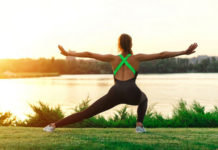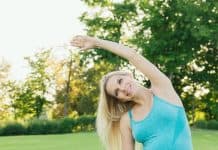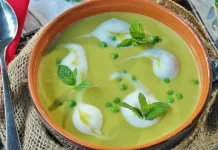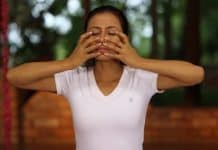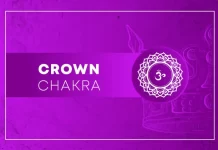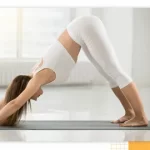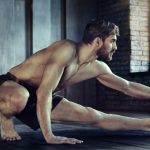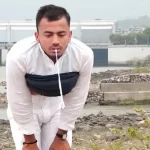Yoga for Anxiety Yoga is a popular choice for individuals seeking relief from stress and anxiety. Many people who experience anxiety employ a combination of methods to manage their symptoms, including therapy, lifestyle adjustments, and often alternative treatments like yoga.
Each year, more than 40 million (18.1%) adults in the United States aged 18 and above suffer from anxiety disorders. While anxiety is a treatable condition, only around 40% of individuals receive the necessary treatment.
Extensive scientific research has demonstrated that yoga can effectively alleviate stress and anxiety. It achieves this by calming the overactive nervous system, promoting relaxation and harmony within both the mind and body. By incorporating techniques such as deep breathing, mindfulness, and physical postures, yoga provides individuals with valuable tools for managing their anxiety symptoms and cultivating a sense of inner tranquility.
How Does Yoga Help with Anxiety?
The COVID-19 pandemic has led to a significant increase in the number of individuals seeking help for anxiety disorders, as indicated by the 2021 State of Mental Health in America Report. Consequently, the demand for effective anxiety management techniques is more critical than ever.
Yoga provides a convenient and adaptable practice that can be performed in the comfort of one’s own home. It can be modified to suit individuals of all body types, abilities, and backgrounds.
For those living with chronic anxiety, their sympathetic nervous system, also known as the fight, flight, or freeze system, is constantly in overdrive. This hyperactive state leads to anxiety symptoms such as restlessness, stress, and rapid heartbeats.
Additionally, individuals with chronic anxiety often have an underactive parasympathetic nervous system, which is responsible for regulating functions like heart rate and digestion, commonly known as the rest-and-digest system.
Research suggests that stimulating the vagus nerve, a crucial component of the rest-and-digest system, is essential in modulating the stress response associated with fight, flight, or freeze. One effective method of stimulating the vagus nerve is through the practice of yoga.
By engaging in yoga poses, breathing exercises, and relaxation techniques, individuals can activate their parasympathetic nervous system and stimulate the vagus nerve. This promotes a state of calm, counteracting the heightened anxiety response.
Incorporating yoga into a regular routine can help individuals with anxiety regain balance in their nervous system, cultivate a sense of inner calm, and enhance overall well-being. It is important to remember that while yoga can be a beneficial tool for anxiety management, it should not replace professional treatment. Individuals with severe anxiety should seek guidance from healthcare professionals to develop a comprehensive management plan.
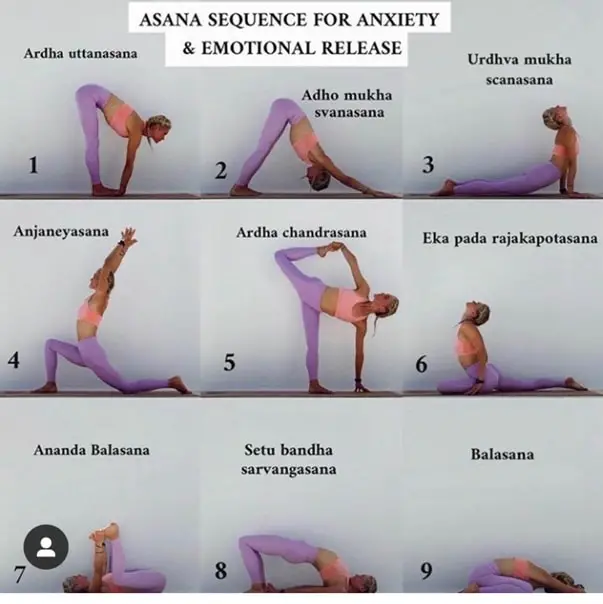
One way to stimulate the vagus nerve is through practicing yoga.
Yoga Poses Stimulate the Vagus Nerve
Valerie Knopik, Ph.D., a psychologist, professor at Purdue University, and yoga instructor at Yoga Medicine based in Indianapolis, Indiana, explains that yoga plays a significant role in stimulating the parasympathetic nervous system, which promotes feelings of safety and calmness. One way it achieves this is by enhancing interoception, our perception of bodily sensations.
By engaging in yoga practices that increase interoception, individuals become more adept at distinguishing between safe and threatening situations. This heightened awareness helps in managing anxiety and creating a sense of security.
Valerie Knopik Moreover, yoga contributes to the enhancement of vagal tone, the ability of the body to relax more swiftly after experiencing stress. The increasing vagal tone has the potential to alleviate symptoms associated with nervous system dysfunction, including anxiety.
Yoga provides numerous opportunities to cultivate interoception and stimulate the vagus nerve. Through physical movements and poses, practitioners can explore and deepen their connection with bodily sensations. This heightened awareness allows individuals to recognize and respond to the sensations arising in their muscles, whether it’s the challenge, stretch, or release they experience.
By consistently engaging in yoga and honing interoceptive skills, individuals can harness the power of the mind-body connection to promote relaxation, reduce anxiety, and foster overall well-being. It’s important to note that yoga should complement professional treatment for anxiety and not serve as a sole solution. Consulting with healthcare professionals is essential for comprehensive anxiety management.
Pranayama Breath Work Connects the Mind & Body
The practice of yoga, which signifies unity, establishes a connection between the mind and body through the breath. Pranayama, the regulation of breath during yoga, is a powerful technique for calming the sympathetic nervous system.
Pranayama involves deliberate control of the breath, sending signals to the brain through the respiratory system. Certain breathing practices, such as the long exhale or diaphragmatic breathing, promote relaxation and a sense of calm by stimulating the vagus nerve and its connection to heart rate variability.
However, it’s important to note that not all pranayama techniques are suitable for anxiety. Some practices, like Kapalabhati or “Breath of Fire,” are invigorating and stimulating, activating the sympathetic nervous system rather than the parasympathetic nervous system.
For individuals with anxiety, pranayama techniques that encourage deep, steady breathing patterns, such as Ujjayi breath, may be more appropriate, depending on the severity of their symptoms.
Meditation Promotes Relaxation
“Meditation is a highly introspective practice that encourages us to observe our thoughts,” explains Knopik. “Engaging in meditation can enhance self-regulation and mindfulness, helping us stay present in our bodies and less caught up in our thoughts.”
Yoga poses, known as asanas, serve as a means to explore the present moment. By mindfully observing the thoughts that arise during movement, we cultivate awareness and create a pathway toward relaxation.
A comprehensive research review conducted in 2012 suggests that meditative therapies, including meditation, yoga, and qigong, among others, are effective in alleviating symptoms of anxiety.
Yoga Poses for Anxiety
The most effective yoga poses for anxiety relief are those that promote a sense of grounding and calm and feel good for your body.
On certain days, slower practices like Hatha, restorative, or Yin yoga may be ideal for clearing the mind and stimulating the body’s relaxation response.
On other days, faster-paced classes like Vinyasa can be equally beneficial, as the movement helps release stress and anxiety.
However, it’s important to consider individual circumstances. When anxiety levels are high, engaging in still postures or seated practices may be distressing, as the mind is often racing. In such cases, individuals who have developed breathwork, self-regulation, and interoception skills may benefit more from faster-paced styles of yoga, as they can remain calm and centered throughout the practice.
For those without these skills, it may be necessary to engage in movement-based practices first to release nervous or anxious energy before transitioning to still postures or practices that promote a sense of calm.
Experienced practitioners may find that standing and balancing postures contribute to feeling grounded and present, but it is generally recommended to incorporate movement prior to these postures.
It is important to listen to your body, experiment with different styles and poses, and find what works best for you in managing anxiety through yoga.
Yoga Sequence for Anxiety
The following yoga sequence provides gentle movements aimed at promoting relaxation and relieving stress.
Several poses in the sequence focus on releasing tension in the neck and shoulders, while others target the psoas muscle, a hip flexor that connects to the diaphragm. Tightness in the psoas can restrict and shorten the breath, which may contribute to feelings of anxiety.
If you prefer a more active practice, you can incorporate Sun Salutations (Surya Namaskar A) into the yoga sequence. Sun Salutations involve synchronized breath and movement, flowing from one pose to the next. They are commonly practiced in Vinyasa yoga classes.
Consider adding Sun Salutations to the following yoga for anxiety routine to enhance the overall practice.
Seated Neck Stretch
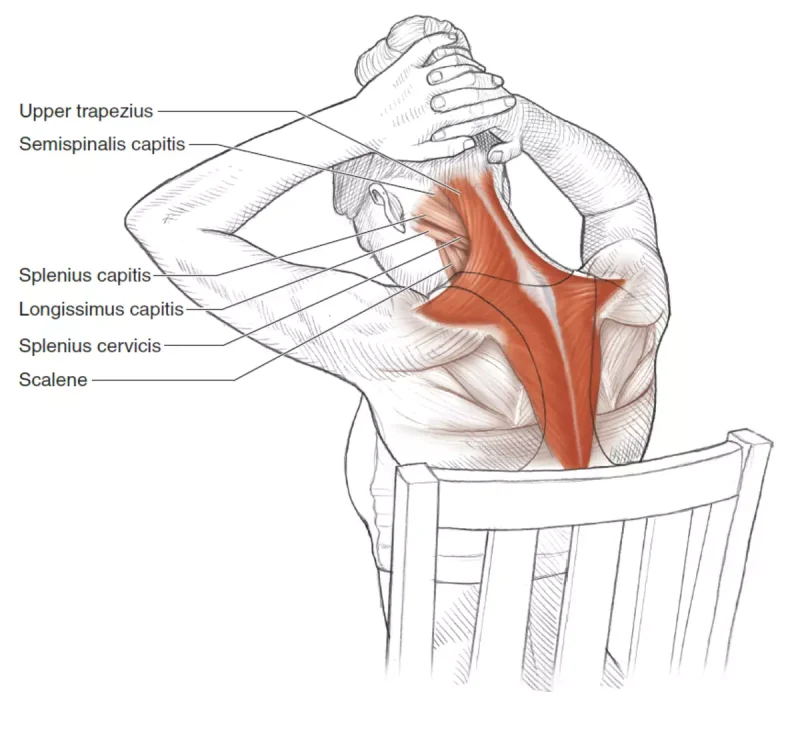
To practice the Seated Neck Stretch:
- Start in Easy Pose (Sukhasana), a comfortable cross-legged seat.
- Inhale deeply and reach your right arm overhead.
- Exhale as you place your right palm over your left ear, gently guiding your head to the right and chin toward your chest.
- Hold this position for 3 to 5 complete breath cycles, allowing the stretch to release any tension.
- Release the stretch and switch sides, bringing your left arm overhead and repeating the process.
- If desired, you can enhance your comfort and support by placing a blanket under your bottom. Alternatively, you can perform this stretch while seated in a chair.
To practice Cat Pose (Marjaryasana):

Cow Pose
To practice Cow Pose (Bitilasana):
- From Cat Pose, exhale and drop your belly towards the floor.
- Broaden through your chest and lift your heart, allowing your shoulder blades to draw together.
- Extend the crown of your head and tailbone upward, creating a gentle arch in your back.
- Rotate your inner elbows forward, maintaining stability in your shoulders.
- Inhale as you transition back to Cat Pose, rounding your spine.
- Exhale and return to Cow Pose.
- Repeat this movement pattern for 5-7 cycles of breath, synchronizing each movement with your breath.
Note: Cat and Cow Pose are often practiced together as a flowing sequence to promote spinal mobility and flexibility.
Extended Puppy Pose
To practice Extended Puppy Pose (Uttana Shishosana):
- Start in a tabletop position, with your hands aligned under your shoulders and your knees under your hips.
- Shift your hands slightly forward and walk your knees back, keeping them hip-width apart.
- Press your palms firmly into the mat as you lengthen your arms and reach your hips back towards your heels.
- Allow your forehead to rest on the mat, releasing any tension in your neck and shoulders.
- Take slow and deep breaths in and out through your nose, focusing on relaxing and elongating your spine.
- Stay in this pose for 5-7 cycles of breath, allowing your body to soften and surrender.
- Optional: If you’re more experienced, you can tuck your toes under and lift your hips up and back, transitioning into Downward-Facing Dog (Adho Mukha Svanasana).
Note: You can use a blanket under your knees and shins for added support and cushioning, especially if you find any discomfort in those areas.
Half Splits
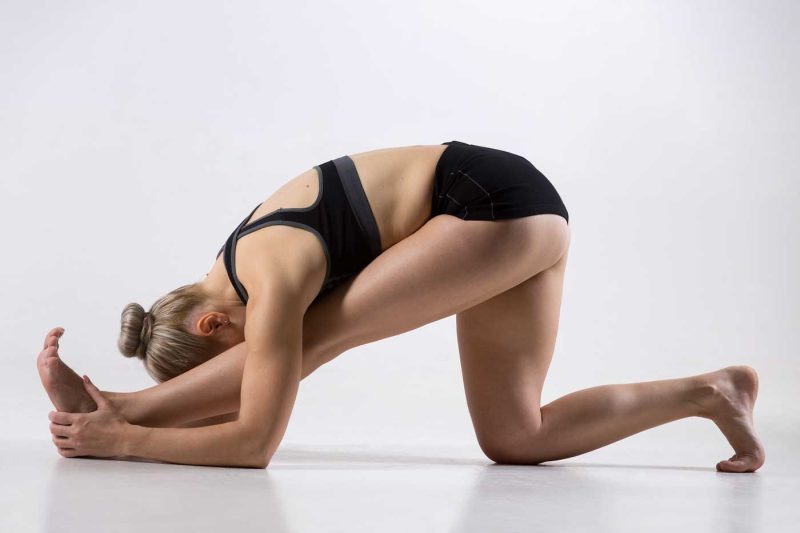
Seated Forward Bend
To practice Seated Forward Bend (Paschimottanasana):
- Start in a comfortable seated position with your legs extended straight out in front of you.
- Shift your buttocks back towards your heels, creating space and length in your spine.
- Sit up tall, engage your core muscles, and flex your feet.
- Inhale as you reach your arms overhead, lengthening your spine.
- Exhale and hinge at your hips, slowly folding your torso forward towards your thighs.
- Place your hands on the outsides of your thighs, calves, ankles, or feet, depending on your flexibility.
- Allow your chin to gently drop towards your chest, releasing any tension in the back of your neck.
- Take deep breaths, allowing yourself to soften and relax with each exhale.
- Remain in this position for 5-7 cycles of breath, focusing on releasing tension and finding a comfortable stretch.
- Optional: If your hamstrings are tight or you need extra support, you can place a rolled-up blanket under the backs of your knees
Remember to listen to your body and honor your limitations. If you feel any discomfort or pain, ease out of the pose and make adjustments as needed.
Constructive Rest
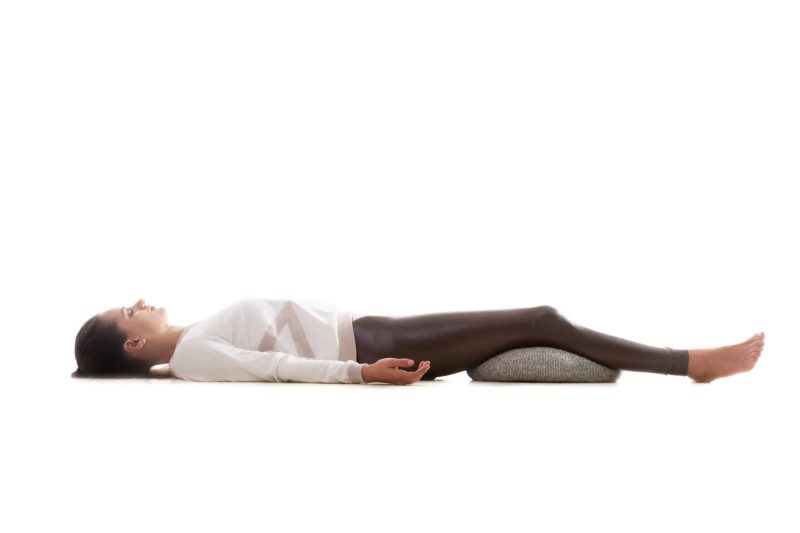
To practice Constructive Rest (Savasana Variation Bent Legs):
- Lie on your back with your knees bent and your feet flat on the floor. Place your arms by your sides with your palms facing up.
- Adjust the position of your feet and arms until you feel comfortable and supported.
- Allow your spine to find its natural curve, maintaining a slight curvature at the back of your neck (cervical spine) and your lower back (lumbar spine).
- Create space between your chin and chest, and extend your arms slightly wider.
- Take deep breaths, allowing your body to relax and release tension. This pose is particularly effective for releasing the psoas muscle and restoring balance to your nervous system.
- Remain in this position for a few minutes or as long as you like, focusing on your breath and allowing your body to unwind.
- Optional: If it feels comfortable, you can widen your feet to the outside edges of your mat and allow your knees to gently come closer together.
Supine Spinal Twist
To practice Supine Spinal Twist (Supta Matsyendrasana):
- From the Constructive Rest position, widen your feet to the outside edges of your mat if they’re not already there.
- Take a deep breath in, and as you exhale, allow both knees to fall over to the right side, keeping your legs staggered.
- Gently turn your chin to the left to deepen the twist and increase the stretch.
- Breathe deeply into your belly, focusing on lengthening your exhales and allowing your body to relax into the twist.
- After 5–7 cycles of breath, inhale to bring your knees and chin back to their starting position, adjusting your hips if needed.
- Exhale and drop your knees to the left side, while turning your chin to the right.
- Optional: Stack or wrap your legs for a deeper twist, if comfortable and accessible for you.
Corpse Pose (Savasana)
To practice Corpse Pose (Savasana):
- From the Constructive Rest position, gently extend your legs out long and find a comfortable position for your arms, allowing them to rest by your sides.
- To enhance your experience, you can use yoga props to support your body and create a sense of grounding and safety. For example, placing a folded blanket over your abdomen or a bolster under your knees can provide added comfort.
- If your mind is still active and racing, you can choose to keep your Savasana relatively short, around 1 to 2 minutes. If closing your eyes feels uncomfortable, you can keep them open and softly fix your gaze on a point above you, while remaining mindful of your breath.
- Optional: To deepen your relaxation, you may choose to listen to a guided meditation or play ambient music that promotes a peaceful atmosphere.
Is Yoga More Effective Than Clinical Treatment?
While yoga can be beneficial for relieving stress and anxiety, it is important to recognize that it should not be seen as a replacement for clinical treatment, particularly in cases of severe anxiety disorders or panic attacks.
While some individuals may experience a temporary “yoga high” during their practice that provides a sense of relief, it is crucial to understand that this emotional state is often short-lived.
In fact, a recent study conducted in 2021 suggests that mindfulness practices, including yoga, can sometimes have the opposite effect and actually increase anxiety levels.
While yoga can serve as a healthy coping mechanism, relying solely on it to address a psychological condition is not a comprehensive and long-term solution.
According to Knopik, it is essential to avoid extremes in any activity, as our bodies and minds benefit from variety. It is recommended to explore multiple strategies and resources for anxiety relief, as having a diverse range of coping mechanisms can be most beneficial for individuals managing stress and anxiety.
Ultimately, it is important to seek professional help and develop a holistic approach that combines various treatment modalities, including therapy, medication, lifestyle changes, and complementary practices like yoga, to effectively manage anxiety and promote overall well-being.
How to Get Started
While research reviews from 2018 have shown that yoga can be beneficial for reducing symptoms associated with anxiety disorders, it is important to note that more clinical studies are still necessary to establish yoga as a first-line treatment for anxiety.
It is always recommended to consult with a healthcare professional or mental health practitioner to determine if yoga is appropriate for your individual needs. When used in conjunction with psychotherapy, medication, or other treatments, yoga can serve as a valuable complement to your overall treatment plan.
One of the advantages of yoga is its ability to enhance self-efficacy, which can be a valuable tool in managing anxiety by promoting a sense of control and confidence.
To start keeping a yoga diary, it is usually safer and more effective to study in person with a certified yoga instructor. However, if attending a full-time class is not feasible, many Yaga studies now offer online broadcast options. In addition, there are many instructional videos available on platforms such as YouTube, often for free.

